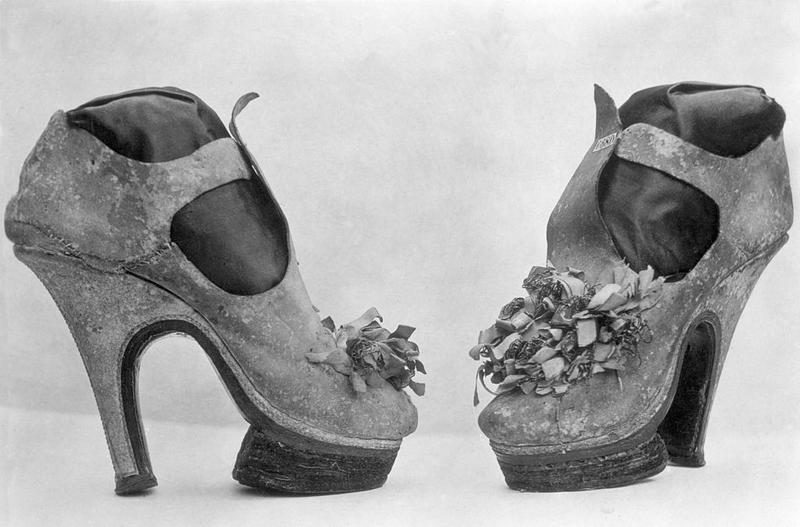History Of Women's Shoes: How High Heels Eventually Became Feminine
By | December 11, 2020

Today, the sexy stiletto is a symbol of feminine beauty, but like most such symbols, it comes at a cost. Women often joke that the tightest, highest, and most uncomfortable heels must have been designed by men, but the truth is that high-heeled shoes were originally only worn by men, and they endured their fair share of controversy on their journey to become staples of women's fashion.
Ancient High Heels
The earliest high-heeled shoes that we know about come from Ancient Greece, where theater was everything. Much like those behind today's Hollywood blockbusters, production designers used their own visual language to communicate elements of a story to audiences, including the use of heeled shoes to make characters of higher social status appear taller than their low-status counterparts. Incidentally, all Greek actors were men. Meanwhile, tons of ancient heels have been unearthed in Egypt, which historians believe were worn exclusively for ritual ceremonies, possibly to bring the wearer closer to the sky and therefore the gods.

The Middle Ages Through The Victorian Era
In 15th-century Venice, men and women both wore a makeshift high heel of sorts, but it was for practical purposes, not fashionable ones. These shoes were more of a tall platform, sometimes as tall as two feet, that were designed to lift the wearer above the muddy, dirty streets, protecting their actual shoes and clothing from getting ruined. Meanwhile, soldiers in the Middle Ages found that high-heeled shoes helped them mount their horses, and once astride, they kept them in the saddle and balanced their weight on the horse.
That all changed in 1533, when the 4'9" Catherine de' Medici decided she wanted to be taller on her wedding day. She rejected the cumbersome platform shoes, as no bride (especially a royal one) wants to risk a face-plant on her big day, so designers presented her with a pair of heels that were more like a daintier version of the riding heels that men wore. Soon, other fashionable 16th-century women clamored for their own pair of feminine heels.
That didn't mean heels were out for men. King Louis XIV of France, who reigned from 1643 to 1715, loved to display his wealth and status in the form of elaborate costumes and oversize wigs, and like all aristocratic men of his day, he had a particular fondness for high-heeled shoes. He was also a pretty short dude, so it helped that they made him appear taller and more imposing. One day, Louis commissioned his shoemakers to craft him a special pair of shoes with red heels and then demanded that red heels be worn by all the male members of his court. If any wannabes took to wearing red heels, the King ordered them imprisoned and sometimes even executed.
During the Victorian era, new manufacturing techniques improved the quality of women's shoes, and the modern high-heeled bootie made its appearance. The heels were dainty and not too high, giving the wearer a more refined appearance and comfortable stance.

20th-Century Heels
Heels on women's shoes remained relatively unchanged—that is, low and chunky—until after World War II, when the Italian stiletto took the fashion world by storm with its tall, thin spike of a heel. The stiletto, which creator Roger Vivier named after the Italian word for the thin dagger it resembles, was not without controversy, as the distinctly feminine shoes made women seem alluring and commanding at the same time. Some feared a woman in stilettos, and others were concerned that her spiky heels could damage any floor—or injure any person—she walked all over. Doctors even warned that stilettos could permanently damage a woman's feet, although the most that's ever been confirmed is a few blisters.
During the disco era of the 1970s, platform shoes made a short-term comeback among both men and women who wanted to be tall enough to see and be seen on the dance floor, but while truly high heels are all but exclusively relegated to women's fashion today, it's not uncommon to find a low heel on men's shoes. Popular culture still equates height with masculine power and competence, which encourages diminutive men to adopt a low heel just as it discourages executive women from donning towering pumps.

Scandalous Shoes
Those platform shoes of old and recent alike didn't come without their dangers. Numerous reports of women falling from their platform shoes and severely injuring themselves are littered throughout history, including a few cases of pregnant women who miscarried after such a tumble. As a result, some cities passed laws prohibiting the dangerous fashion, but women still wanted to be taller and keep their hems off the ground, so shoemakers shaved down the front of the platform to better accommodate the toes and ball of the foot, added arch supports, and stabilized the heel to increase the safety and comfort of platform shoes.
People of lower classes often take their fashion cues from the upper classes, and footwear was no exception. By Shakespeare's time, high-heeled shoes were the favorite footwear of sex workers, something even the Bard himself noted in his writings. England and France actually outlawed high-heeled shoes during this time because of the association. They didn't, weirdly enough, outlaw sex work.

